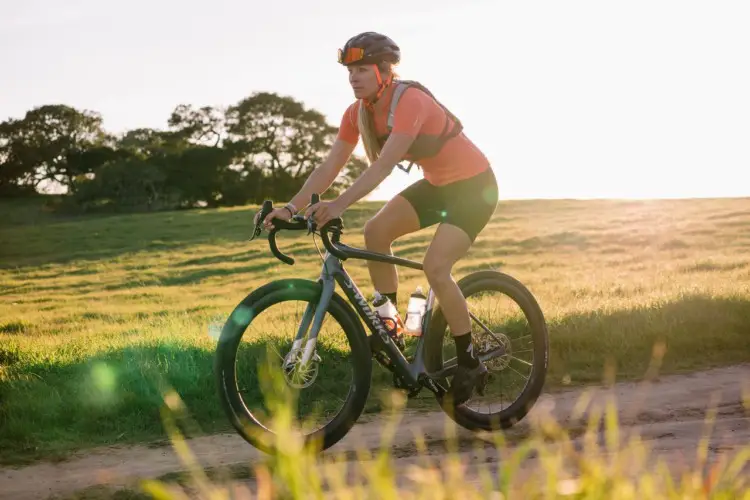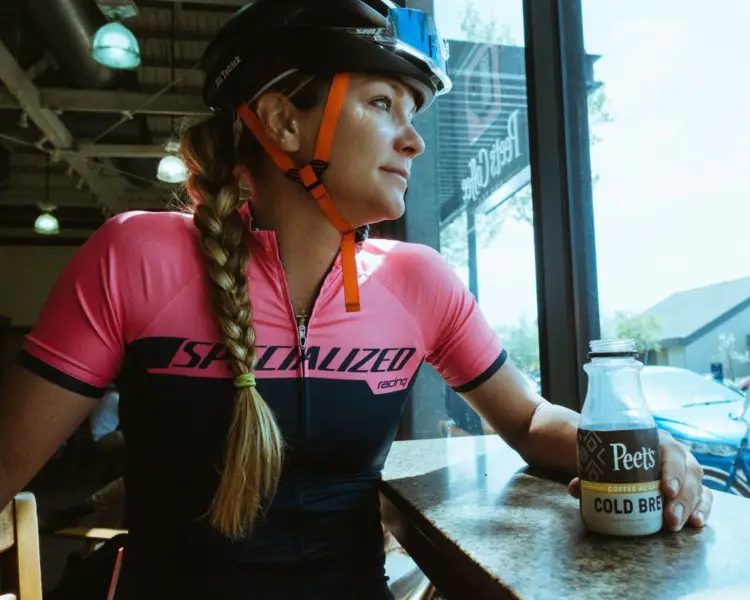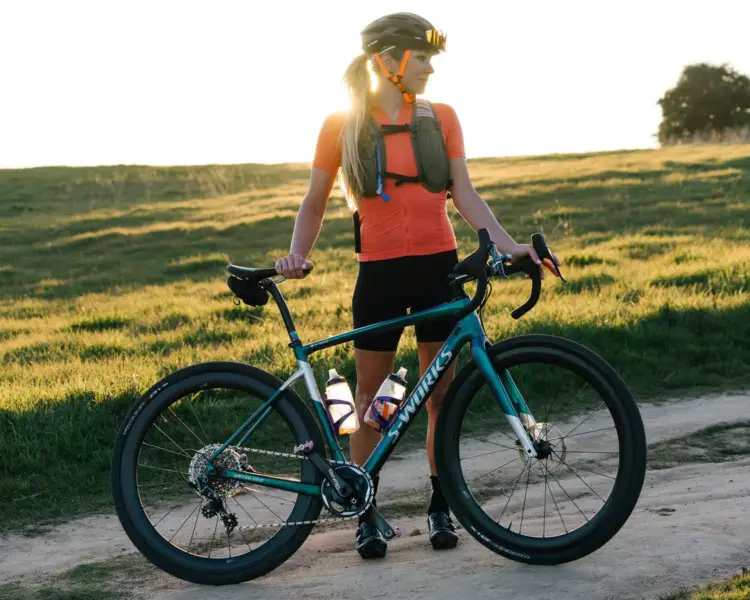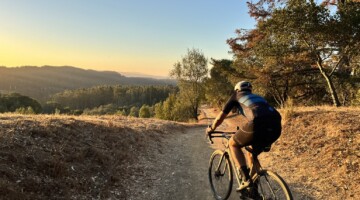
Our coverage of the 2018 Dirty Kanza 200 is brought to you in part by Panaracer. Check out its line of gravel tires for your next adventure.
Last year, Alison Tetrick was a gravel newb when she headed to the start line at the Dirty Kanza 200. After winning the race in a sprint finish against two-time champion Amanda Nauman, the 2018 edition of the famed Kansas race definitely will not be her first rodeo.
Despite returning with the winner’s belt buckle, Tetrick is not feeling any extra pressure for this year’s event. “I hear pressure is a privilege, yet the reason I have started targeting gravel races instead of road is to decrease my tire pressure and increase the fun inhalation,” she said. “I do have a quaint obsession with belt buckles and being a rodeo queen, so I will give the Dirty Kanza 200 (or is it DK20n+1) my best effort.”

Alison Tetrick is back to defend her Dirty Kanza 200 title in 2018. © Cody Mann (Flintlock Photography)
Tetrick was a long-time professional road racer, but this year, she has stepped away from the road and embraced racing on gravel. The decision has been a good one for her. “I have raced on the world’s biggest stages, and I am so happy to come off that stage and join a rad culture and community that are my people,” she said about her new gravel career. “I love that we all have a story to tell at the end of the day as we conquer not only the course but also ourselves.”
We reached out to Tetrick for a pre-DK200 interview to ask her about her new life as a gravel rodeo queen, her new Specialized Diverge bike and what she’s expecting from this year’s race. Stay tuned for more from Tetrick and the other gravel stars from our on-site coverage from the 2018 Dirty Kanza 200.
Interview with Alison Tetrick, Defending Dirty Kanza 200 Champion
Cyclocross Magazine: How has your season been going so far? Where have you been racing this year?
Alison Tetrick: This is my first year in eight years not racing a full pro road calendar. I have tried to fill my schedule with adventure races like the Grasshopper Adventure Series, Belgian Waffle Ride and Chino Gravel Grinder. It has been interesting as I have transitioned my career from an arduous WorldTour program to a more flexible schedule. I think I am traveling and riding my bike more now than ever!
CXM: Are you feeling any extra pressure for DK200 this year as the defending champion?
AT: By pressure, do you mean tire pressure? I hear pressure is a privilege, yet the reason I have started targeting gravel races instead of road is to decrease my tire pressure and increase the fun inhalation. I do have a quaint obsession with belt buckles and being a rodeo queen, so I will give the Dirty Kanza 200 (or is it DK20n+1) my best effort. Gravel racing is about the adventure and self-discovery and anything can happen on any given day, but we all will have a great story to tell. Cowgirl up.
CXM: There are more and more big names like Kaitie Keough tackling Dirty Kanza this year. Does the tougher competition change your preparation at all?
AT: I love that there are more big names coming to the gravel events to increase competition and awareness of this budding discipline of our sport. Ultimately, you have to ride your race and not worry about someone else. It will be a challenging day on the bike, regardless of who shows up. Kaitie and I have been teammates on the road for years, and I am stoked to share the Flint Hills with her. Besides, everyone loves a good solid bike race.

Alison Tetrick says she will be ready to rumble through the Flint Hills come race day. © Cody Mann (Flintlock Photography)
CXM: You hoping to avoid a sprint finish this year? Are you planning on scouting out the finishing stretch this year?
AT: Who sprints after 206 miles? A desperate person. My coach—CTS’s Dean Golich—says that some people who learn by being taught, some learn from experience and some never learn at all. He then follows that up by saying he doesn’t know which one I am. I have made a few repetitive mistakes in the past, but I sure hope I at least remember the basic rules of being a professional cyclist. But I won’t make any promises.
CXM: Last year you said your previous career long ride was 122 miles. Have you changed your training at all this year?
AT: I now can say the longest I have ever ridden is 206 miles last year. I definitely haven’t ridden that distance since, and I am still intimated by that duration. I haven’t changed my training much, as I still focus on my strengths and quality work on the bike. It turns out, I just love riding my bike, and although I do far fewer races and intervals these days, I still suffer with pride.
CXM: Do you race with a power meter? Do you use the data during the ride?
AT: I always train and race with a power meter. I use a Quarq on my SRAM Force 1x for the DK200. As much as I am a scientist and data junkie, when it comes to race day, I don’t look at the numbers. You need to be able to feel your effort and gauge yourself accordingly. We aren’t robots, and weather, course conditions, hydration and physiology can have a huge impact on your power. You never know what power will win that day, which means you need to bank on your confidence in your training and mental fortitude.
I hate it when people say they couldn’t do x, y or z, in a race because the watts were a, b and c. The beautiful thing about bike racing is that you can ride your race until you need to ride faster than anyone else, and at that point it is up to you. It has nothing to do with watts. You either do it or you don’t. No regrets.
CXM: It looks like you have a new bike this year? What does your setup look like?
AT: Oh em gee, I am in love with my bike. I will be riding a Specialized S-Works Diverge with Roval CLX32 Wheels. As far as the rest of the setup, it will remain the same with Orange Seal for tubeless tires, Speedplay SYZR pedals and Camelbak for hydration needs. The Chase Vest is made for the DK200, and I wore a fancy prototype last year, so I am happy to have those packs in my stash again.
I am sticking with the SRAM Force 1x and a Quarq power meter. Just like last year, I will continue to use Lezyne for all the saddle bags, tools, bottle cages and GPS needs. I will be fueled by GU Energy and made much more comfortable with Chamois Butt’r.
You can quote me on this, the setup will be dialed, custom and solid for the course. I have never had so much confidence in my sponsors. We have had a blast collaborating on this setup across many of my partners, and it will be great to debut some fun projects we have been working on this year.

Alison Tetrick will be riding a Specialized Diverge at the 2018 Dirty Kanza 200. © Cody Mann (Flintlock Photography)
CXM: Last year you had the suspension on the Cannondale Slate, this year you have the Future Shock. Do you think front suspension of some kind is a necessity for gravel racing? What is the biggest difference between the two bikes and their suspension?
AT: Gravel races are long. Gravel races are bumpy. Suspension is key for comfort and leaving you a little fresher at hour 11. Wait, who feels fresh then? I will take what I can get!
The Cannondale Slate and Specialized Diverge both have suspension, but the shock is in different areas of the bike. The Diverge is built to suspend the rider and not the bike. It rides more like a traditional road bike, which suits my background. I find it responsive and racey, yet comfortable and bomb proof.
The Specialized Crux, which is a more traditional cyclocross race bike, has a high bottom bracket at 69mm drop and short wheel base. It excels on shorter races held on tight courses. The Diverge has a much lower bottom bracket at 85mm drop and it helps you stay stable at high speeds and gives you the suspension that keeps you from getting beat down. No one wants to be beat down, I would rather get my beat on.
CXM: Last year it sounds like you got a good amount of advice from Cannondale athletes. Anyone new you’re hitting up for round two? Anyone asking you for advice as the Queen of the Dirty Kanza?
AT: This isn’t my first rodeo. I learned from experience and a ton of knowledgeable people last year and have continued to build this database of expertise with the product team at Specialized and my other partners such as Camelbak and Speedplay. Gravel racing has really been great for the cycling industry because many companies are innovating and investing in this side of the sport.
People do ask me for advice, but I still don’t know what tire pressure I ran last year, and I probably won’t know this year. Sometimes it’s best to keep things from me. One less thing for me to fixate on is better. I have given more advice on mental toughness and training than anything else. I even did a training series with FloBikes. There was whiskey and cowboy boots. Check it out.
CXM: How do you make tire selections for gravel races? Do you have a lot of different treads you choose from for a given race?
AT: It used to be the power of Google, and now I am just plain spoiled. I am fortunate to work with a company like Specialized that has tires and treads for every occasion. I am also beyond lucky to have a team of engineers and smart people who I can ask what product to use for optimal performance.
But really, I come from a time trial background where preparation is everything. The internet and past photos and articles can really be informational. Each course is different, and of course, the DK200 is a beast of its own.
CXM: Tubeless setups can take a bit of time to get ready sometimes. How close to race day do you get your tires mounted up?
AT: I use Orange Seal for tubeless capabilities, and I now use tubeless on my road bike too! I like to have a fresh set of tires on my bike for a demanding race like DK200. The newer the tire, the better. It is always good to test the tires out before the race to work out any issues though. There isn’t a perfect formula, but I would say within five days of the race I have my setup complete. I don’t like to be scrambling in the last minute. Stress takes away from my wine time.
CXM: Who are you most worried about heading into this year’s event?
AT: There are absolutely no worries. You can only control your controllables and enjoy the process. I know I will be meeting new places in myself I didn’t know existed. I know I will make new friends, even if they are imaginary. Believe me, after 165 miles, you meet all sorts of creatures. I know it will be a beautiful and painful day.
CXM: How, if at all, did last year’s DK200 change things for you?
AT: Just finishing the DK200 is a mix of drinking all the Kool-Aid and going to summer camp. This gravel thing has changed my life and the trajectory of my career. I would like to think it would be the same without winning, but by winning the race, I have been given some incredible opportunities that I am very thankful for. And let’s not forget that belt buckle that is mine for life. Buckle up.
I have raced on the world’s biggest stages, and I am so happy to come off that stage and join a rad culture and community that are my people. I love that we all have a story to tell at the end of the day as we conquer not only the course but also ourselves.
CXM: Thanks for you time. Looking forward to seeing you buckle up in Kansas.
AT: Thanks!




























